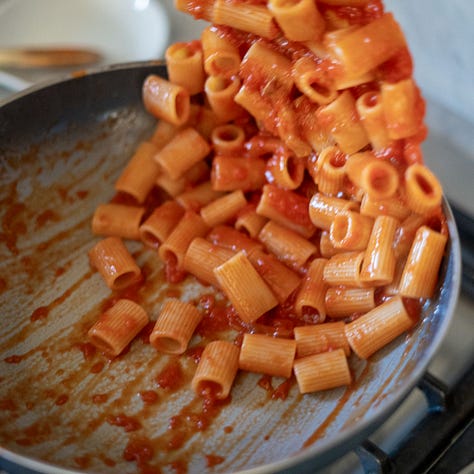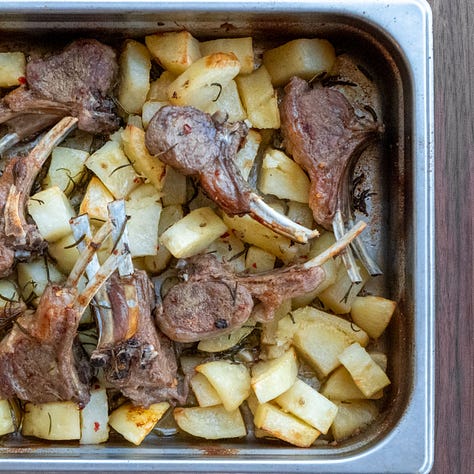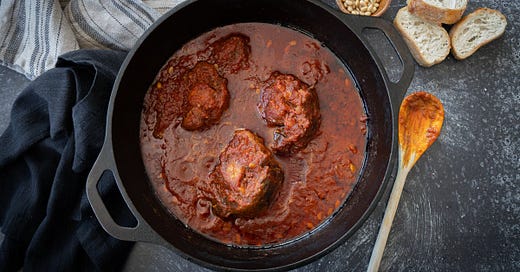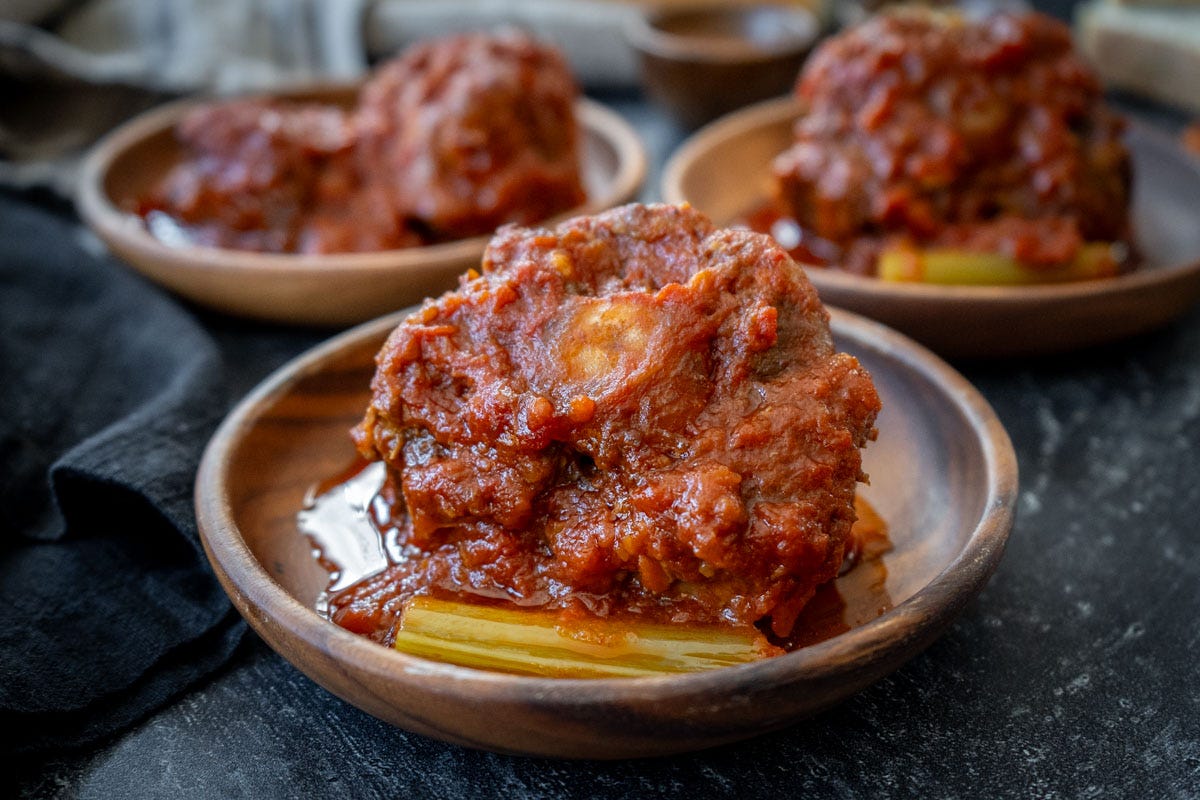Coda alla vaccinara
Il quinto quarto: the humble oxtail is elevated and revered in Roman gastronomy.
Recently, on the eve of a snowstorm, we found ourselves at a birthday gathering with a small group of mostly Italian ex-pats. As often happens in settings like these, origin stories are shared. “How long have you been here?” “What brought you to Minneapolis?” With the arrival of snow on everyone’s mind, there were tales told of navigating Minnesota’s winter weather as a newcomer.
Stefano recalled walking our Newfoundland, Abby, on frigid winter mornings during his first winter in Minnesota, thinking to himself, a) the novelty of the snow wears off quickly when you are deep into a long, cold, winter and b) mental note: avoid wearing button-fly jeans in subzero temperatures.


The only Italian in town
We arrived in Minneapolis in late October of 2001. Busy settling into our new jobs and lives, those early months were a blur, and winter was here before we knew it. It’s hard in normal circumstances to create a new community of friends in a new town. It’s particularly hard during a Minnesota winter when the cold keeps everyone indoors. Social media was still years away, and there simply were not many opportunities to meet new people, especially other Italians in Minneapolis. Stefano truly believed he was the only Italian in town.
One day, I read an article in the local newspaper about an Italian restaurant that had opened in a nearby suburb. The chef, according to the article, was from Rome. “Let’s go,” I urged.
Stefano was skeptical. He’d quickly learned that the descriptor “Italian” was used loosely here in the States, and he’d been let down a few too many times to fall for another bad meal. Still, I pressed, and he reluctantly agreed to try it. So, on a Friday evening, we bundled up our then-3-year-old son Sean, hopped into the car, and drove to the burbs to check the place out.
After being seated and getting situated, we opened the menus and began to read. The menu was organized by antipasti, primi, and secondi, as an Italian menu would be. The dishes had authentic Italian names and were spelled correctly, always a good sign. Notably, a few of the items were classic Roman dishes. It’s been many years, but we both recall that bucatini all’amatriciana and coda alla vaccinara were two of those.
Who ordered coda alla vaccinara?
Still guarded but with a bit of hope creeping in, we placed our orders. Stefano, in a bust-or-go-home moment, ordered the coda alla vaccinara, a Roman-style oxtail stew. Either it would be prepared correctly, or his theory about Italian restaurants in the Twin Cities would be proven correct, and we’d be stopping for a burger on the way home.
Soon after we placed our order, the chef stepped out of the kitchen and made his way toward our table. Stefano was seated with his back toward the kitchen, but I could see him approaching. Maybe the waiter who heard us speaking Italian had tipped him off, or maybe he was just curious. But he was definitely headed our way.
When he arrived, he put his hands on the table, leaned forward, and asked in unmistakenly accented English, “Who ordered the coda alla vaccinara?”
Stefano, who’d observed the name “Filippo” embroidered on his double-breasted chef’s coat, did not answer his question but instead replied in near disbelief, “Ma che sei di Roma?” Are you from Rome?
Filippo was, in fact, from Roma. Like Stefano, he cheered for the A.S. Roma soccer team, not Lazio, the archnemesis team (the importance of this is not to be underestimated). And, having lived in Minnesota for several years already, he knew many other Italians. They exchanged numbers, and just like that, Stefano had made his first Italian friend in Minnesota.
Il quinto quarto
The term Il quinto quarto, which translates to "the fifth quarter," dates back to the historical slaughterhouses in Rome’s Testaccio neighborhood in the early 1900s. The cattle butchers, known as vaccinari, divided the animal into four quarters, two from the front and two from the back, before then butchering the pieces into smaller cuts. These more desirable cuts of meat were reserved for the wealthy, while the scraps—the tail, feet, head, organs, and intestines—were left for the working class.
These less prestigious parts of the animal, which some claim equal one-fourth of the animal’s weight, became known as il quinto quarto, or the fifth quarter. Over time, these humble dishes made from lesser cuts of meat and offal became cherished staples of the Roman culinary tradition. Coda alla vaccinara is one of these quinto quarto dishes. Coda means “tail,” in this case, oxtail, which is slow-cooked in a tomato-based sauce until the meat falls off the bone.
The traditional recipe calls for cloves, cinnamon or cocoa, pine nuts, and raisins. Not everyone appreciates those flavors, so feel free to experiment, and if it’s not to your liking, leave them out.
Ingredients
4 servings
2-3 lbs oxtail, cut into pieces
2 tbsp olive oil
1/4 cup guanciale, chopped
1/4 cup onion, diced
1/4 cup celery, diced, plus one stalk
1/4 cup carrot, diced
2 cloves of garlic, diced
Two 28 oz. cans whole peeled San Marzano tomatoes
1 cup dry white wine
1 bay leaf
2 whole cloves
1 tsp cinnamon or unsweetened cocoa powder
Salt and black pepper, to taste
A handful of pine nuts
A handful of raisins
Instructions
In a large heavy-bottomed pot, heat olive oil over medium-high heat. Salt and pepper the pieces of oxtail on all sides and sear them in the oil, turning them until browned on all sides.
Add the guanciale to the olive oil and cook until it renders fat. Add the diced onions, carrots, celery, and garlic. Sauté for about 10 minutes.
Increase the heat, pour in the white wine, and Let it reduce for several minutes.
Add the whole tomatoes, passing them through a food mill first to remove the skin and seeds or crushing them with your hands.
Add the bay leaf, cinnamon or cocoa powder, salt, and pepper.
Cover and simmer on low heat for 4 hours, stirring occasionally, until the meat is tender and begins to fall off the bone.
In the final 30 minutes, add the celery stalk cut into thin strips, pine nuts, and the raisins.
Remove the oxtail from heat and let it rest a few minutes before serving.
Enjoy oxtail on its own with plenty of crusty bread, or for a heartier dish, serve it over polenta.
For our local readers, Filippo is chef Filippo Caffari, one-time chef of I Nonni in Lilydale and later chef and owner of the Butcher Block in Northeast Minneapolis. Filippo is semi-retired now, but you can sometimes find him at the market at Cossetta’s in Saint Paul, where he oversees recipe development.
You may also like…











